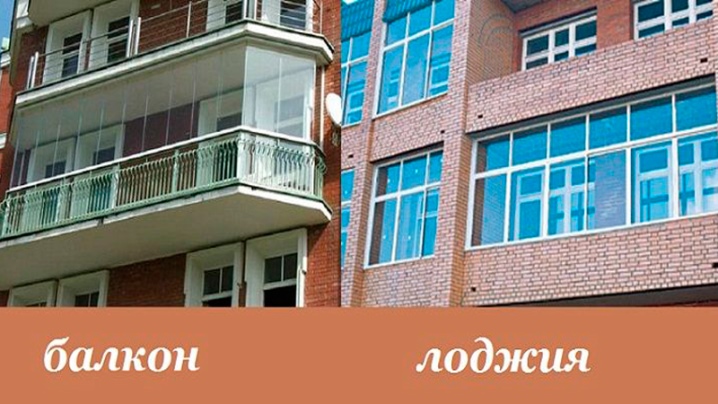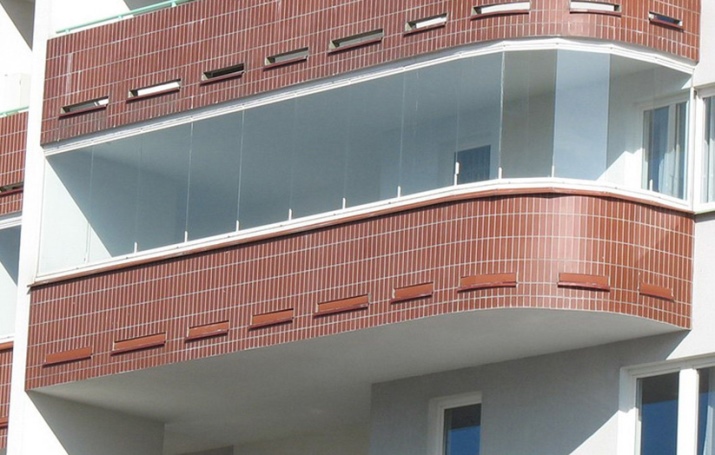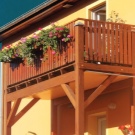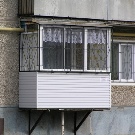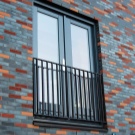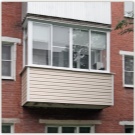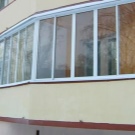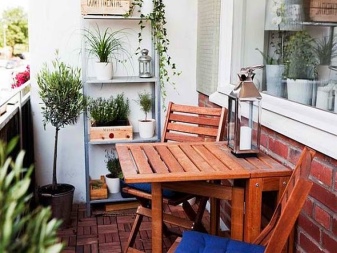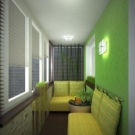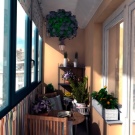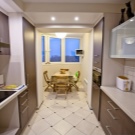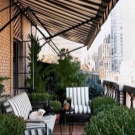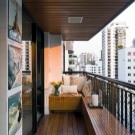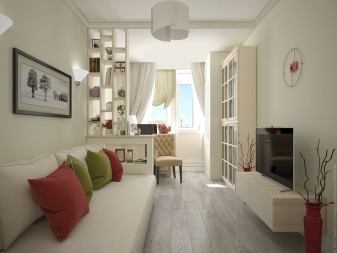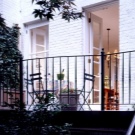How does a balcony differ from a loggia?
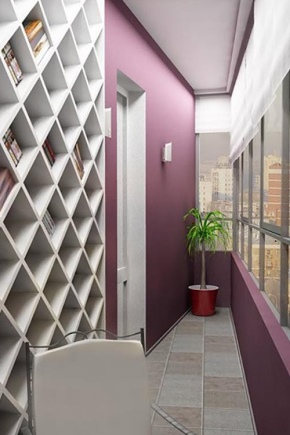
Modern apartment building is impossible to imagine without a spacious loggia or a cozy balcony. There are stored a lot of useful and not very necessary things, clothes are dried, cans with home-made preparations are stored.
Sometimes this space is used as a full continuation of the living space. They arrange a study, a play area, a small workshop. Very often, the concepts of "loggia" and "balcony" are confused, assuming that they are identical. However, this is not the case. These two structures have several constructive differences, which will be discussed in our article.
What is a balcony, and what is a loggia?
Visually distinguishing these structures is very simple. The balcony is a projection near the windows,which has enough space to accommodate furniture, store things or use for other purposes.
Loggia is a niche, a recess in the wall. From the side of the street, it looks flush with the facade, while the balcony largely protrudes from it. This is a distinction at the philistine level. Correctly determine what constitutes each structure, help SNiP (building codes).
According to building regulations, a balcony is a fortified platform that protrudes from the plane of the wall. Depending on the shape, size, type of construction and other parameters, balconies may differ from each other.
By type of construction a balcony is:
- Typical. The most common option, which today can be found in all typical buildings. Such designs differ from each other in the presence of glazing, various finishes, types of fencing and other elements.
- Attached. This type can most often be found on the first two floors of the building. This design has a free space, where the balcony supports are located.
- Attached.Such a balcony, as a rule, is mounted to the existing building. The design must have remote console beams for fastening the structure to the wall and front supports to reduce the load on the facade of the building.
- Hinged. This design is fixed on the facade with fasteners. It differs from other types in that no additional supports are required for fixation. Due to this, the hinged balcony can be mounted on any floor. It has several varieties of appearance.
- Forged. Balcony with elements of wrought metal. It can be supports, railings, fencing, or all together.
- French. Its principal difference is the partial or total absence of the site. Most often it is used as a decorative fence for windows. Differs in compact overall dimensions and design elegance.
A typical balcony is a reinforced concrete slab protruding from the wall of a building and fenced with a metal grill. The grille can be open, covered with decorative plates or sheets of flat slate. The plate is fixed only from the entrance side, therefore it is not recommended to overload the balcony with overly massive structures andheavy finishing materials.
By the presence of glass balconies can be glazed and open. Today, it is increasingly possible to meet exactly the first design option. In an attempt to protect themselves and their homes from noise, dust, insects, precipitation, people close the balcony with transparent glass. This method allows you to slightly expand their living space.
Glazing can be partial, when the lower part of the balcony remains closed, and full, when the balcony space is covered with floor-to-ceiling glass.
Loggia is not issued for the facade of the house and is fenced, as a rule, on three or two sides, while the balcony is on one side only. The depth of its drowning in the wall depends on the standards of natural lighting for the room, which is adjacent to this wall. The concrete slab, which serves as a basis for it, rests on the bearing or semi-supporting walls of the house.
The open part of the loggia is limited to a metal, concrete, stone, wood, glass or other parapet.
Depending on the design features of the loggia is:
- Built. With this option, the loggia has only one open side. The support is carried out on the bearing wall of the house.
- Remote The base plate rests on the console walls, which are attached to the house.
- Corner. With this option, the two sides of the loggia are closed, and two are open.
Loggia can be closed with glass or remain open. True, the glazing in any case may be partial. The lower part of the loggia must be closed with a brick, concrete or metal fence.
Inner space loggia can also be used as a full-fledged living space, even without resorting to its expansion.
It is believed that the loggias can not be heated, but it is not. Moreover, in some administrative buildings, loggias are used as recreation areas for employees. Accordingly, it provides radiator heating to ensure a comfortable environment for rest. Some loggias have windows in the side walls due to their design features.
The main differences
Balcony and loggia differ in several parameters:
- By constructive type. Balcony - remote element of the building, loggia - recessed.
- The number of closed sides. Only one wall at the entrance is closed at the balcony, and at the loggia there are two (in the case of a corner structure) or three.
- Strength.The support for the balcony is a remote plate, so it has significant weight limitations. That is, it is not recommended to make a concrete screed on the floor, install massive furniture or use heavy finishing material for cladding. The support for the loggia is the supporting structure of the building, therefore from this point of view it is a more reliable and sturdy structure.
- Square. Usually the balcony has much smaller overall dimensions. Its length is limited by the size of the base plate, and the length of the loggia - the size of the adjacent room. This is due to all the same design features. Balcony - portable design, so it can not be too spacious.
- Differences by SNiP. According to building codes, the balcony is a fenced cantilever slab that protrudes outside the facade and is closed on one side only.
The balcony is limited by the weight of furniture available on it. The balcony is less functional than the loggia. Since there are weight restrictions, it is recommended to choose light aluminum frames for glazing the balcony. For glazing loggia can be used plastic windows.A loggia can increase the area of a room adjacent to it, but a balcony does not.
The difference in functionality and arrangement
As for the functionality of these facilities, the loggia wins. For example, already at the stage of repair more funds are invested in the balcony space. It must be insulated and glazed on three sides, while the loggia is only on one side or, in rare cases, on two sides. On the other hand, a balcony that occupies a smaller area requires less financial investment in the arrangement of the floor and ceiling.
Loggia - part of the apartment, while the balcony - portable design. It has less functionality for arranging it for a study or a game zone. The limited load and small width noticeably reduce its potential.
Loggia can be turned into almost any designated room. Free space and good natural lighting allow you to use it as a study. For his device does not need a lot of furniture: enough desk, necessary office equipment, shelves or cabinets for documents. If necessary, natural lighting can always be enhanced by artificial (built-in lamps, chandeliers, sconces).
A small tea table, sunbed or rocking chair will allow you to turn the loggia into a cozy place to relax over a cup of coffee or a favorite book.
A rack or chest of drawers for children’s toys, a soft, shaggy carpet on the floor, a drawing board and other little things will make the loggia a play area for children of different ages. In this case, of course, it is necessary to secure the space as much as possible: exclude the presence of sharp corners and dangerous objects, install clamps on the double-glazed windows.
The winter garden or greenhouse is a “green” corner, which can be arranged both on the loggia and on the balcony. A planter or flower pots can be placed around the perimeter of the parapet, from the outside or placed on the floor.
The spacious loggia often becomes a continuation of the dining or kitchen area. Here you can set a rectangular or round table, table top or even a bar counter. The balcony is limited in these possibilities, since it cannot be warmed with the help of central heating radiators, and it is not always convenient to use portable heaters, and it is quite expensive.
Loggia allows you to install a heater, air conditioning, to warm the floor, use a variety of finishes and decor elements, arrange a massive, heavy furniture.
In addition to the above examples, a loggia is an ideal space for creating a home library, wardrobe, living room, summer kitchen, workshop and other rooms. It is enough to show your imagination and the usual loggia will turn into an additional, functionally significant room.
The choice of premises in which the loggia or balcony will be converted depends on their area, dimensions, design features and capabilities.
Balcony can also be a great place to relax, plant plants, storage of mass of useful things. To do this, it is quite possible to place light shelves, small bedside tables or shelves. They can be further used for placing sports equipment, clothing, bedding, toys, household utensils, sewing accessories, tools.
By the way, the balcony can be an excellent greenhouse for growing some types of vegetables, fruits or flowers.
What's better?
An unequivocal answer to this question, of course, cannot be given. And the one and the other structure has a lot of advantages and disadvantages. Some people like the feeling of open space, which gives a balcony. Thanks to the panoramic view, you can watch everything that happens around. The loggia does not give such an effect, because it is closed on three sides out of four possible.
The room adjoining the balcony is much lighter than the one that adjoins the loggia due to the natural luminous flux, but in the winter it is cooler. A balcony is an ideal option for those who like compact and neat facilities to ensure the most necessary functions - to dry laundry, to keep useful things, to have an open source of fresh air in your apartment.
The balcony is ideal for those people who prefer a functionally significant room, a beautiful, stylish element of the facade decor. In this regard, the loggia is significantly inferior to the balcony, being, in essence, an extension of the wall and not carrying any aesthetic value. The variety of balcony gratings and fences, forms and designs is amazing. Especially when it comes to balconies, decorated with the use of artistic forging.
The facade, decorated with round and curved wrought iron grilles with decorative metal elements, resembles a royal palace rather than a residential building. The French balcony does not carry absolutely no functional load, but it is a magnificent example of decor.
Those who want to expand their housing by adding another full room to it, of course, prefer spacious loggias. They are much safer from a constructive point of view, have large dimensions and give more opportunities. They give less light, but they freeze through much less in winter, and there are practically no drafts from them, which is not the case with balconies. Although it largely depends on the quality of the repair.
So, both the balcony and the loggia have their pros and cons. However, if you wish, by showing a little imagination, you can turn any of them into a full-fledged, comfortable and cozy room for household and household needs.
